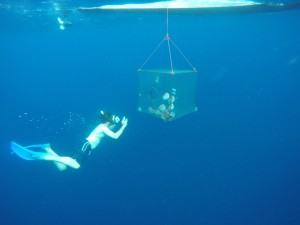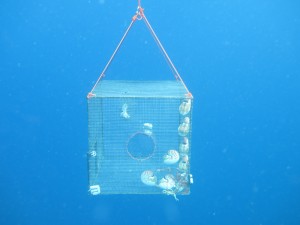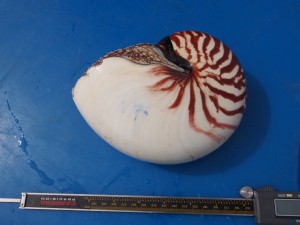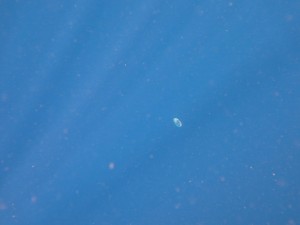Part 4-Search for the Fuzzy Nautilus
Success!!! We caught nautiluses!!
On our second day of trapping in Kavieng we set our traps in a different area and we successfully caught several nautiluses in the trap. It sure made the hour pulling up the trap so much worth it when something is in it! But once we pulled the trap and nautiluses to the surface, we had to immediately start ‘processing’ them and release them.
‘Processing’ a nautilus is simply collecting data from it. We first put the nautiluses in a chilled aquarium on board the boat. Nautiluses live in deep, cold water so if we live them in warm water for too long, they will begin to get stressed out and could potentially die. We keep them in the aquarium that is about 18 °C (or 65 °F). Then, we measure the shell diameter and width, determine their sex and maturity, collect non-lethal tissue samples for genetic analyses, and finally mark and photograph them. Recording the information will help us know what the population looks like as a whole so we can answer questions such as, what is the male to female ratio or how many of the nautiluses are mature and how many are juveniles?
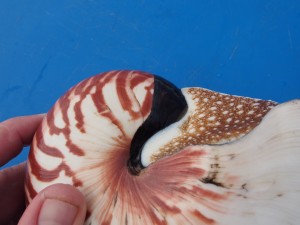
Photograph of Nautilus pompilius showing scars (black marks) on nautilus shell. (Photo by Peter Ward)
Just by looking at the shell, we can find out so much. Juvenile nautiluses have stripes that extend all the way to the end, or aperture, of the shell. In adults, the stripes stop and the bottom, or ventral, portion of the shell is all white.
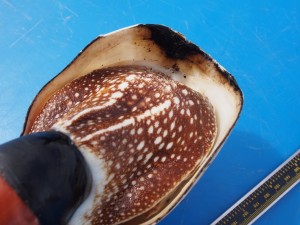
Photograph of Nautilus pompilius showing black deposits made on shell aperture. (Photo by Peter Ward)
One very interesting thing about their shell is its growth. Just like humans, nautiluses stop growing at a certain point but they continue to live and age. While we know at about what time nautiluses become mature and stop growing larger shells (12-15 years), we do not have a good method of aging nautiluses pass this point. Perhaps nautiluses live 20, 50, or 100 years? With deep sea, cold water species that is not abnormal. We just haven’t found the nautiluses’ gray hairs or wrinkles, as humans have, to know just how old they can grow. Dr. Ward thinks we may be able to age them by looking at black deposits that build up on the aperture of the shell after the nautilus reaches full growth.

Greg (orange snorkel), Rick (right), and Manuai (back) snorkeling with and burping nautiluses (Photo by Peter Ward)
Each nautilus takes about 5 minutes to process. Once all of the nautiluses are processed, we release them back to the sea. But we can’t do that until we burp them. When nautiluses are exposed to air, air bubbles may get trapped in their shell and if they are not released, or burped, can cause the nautilus to be positively buoyant and float on the surface or potentially cause a fatal infection. So, we snorkel with the nautiluses and burp them for as long as it takes (sometimes 60 minutes) until they begin to descend back down to their 300m depths.
All of our hard work finally paid off, sort of. While we caught Nautilus pompilius, we had still not found any of the fuzzy nautiluses (Allonautilus scrobiculatus). So, it was off to a new location in Papua New Guinea to continue our search for the fuzzy nautilus…


